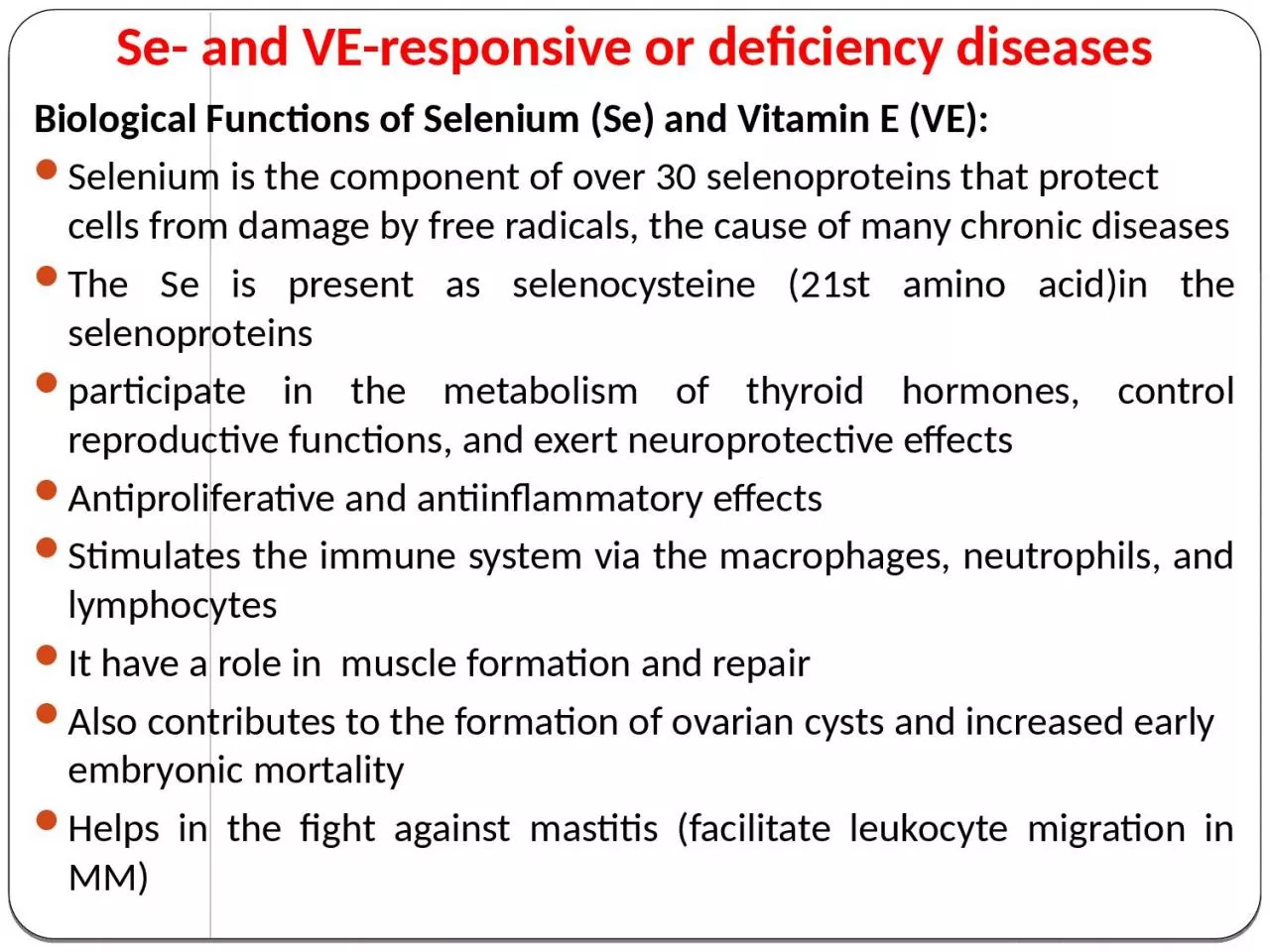

Biological Functions of Selenium Se and Vitamin E VE Selenium is the component of over 30 selenoproteins that protect cells from damage by free radicals the cause of many chronic diseases ID: 915931
Download Presentation The PPT/PDF document "Se- and VE-responsive or deficiency dise..." is the property of its rightful owner. Permission is granted to download and print the materials on this web site for personal, non-commercial use only, and to display it on your personal computer provided you do not modify the materials and that you retain all copyright notices contained in the materials. By downloading content from our website, you accept the terms of this agreement.
Slide1
Se- and VE-responsive or deficiency diseases
Biological Functions of Selenium (Se) and Vitamin E (VE):
Selenium is the component of over 30
selenoproteins
that protect cells from damage by free radicals, the cause of many chronic diseases
The Se is present as
selenocysteine
(21st amino acid)in the
selenoproteins
participate in the metabolism of thyroid hormones, control reproductive functions, and exert
neuroprotective
effects
Antiproliferative
and
antiinflammatory
effects
Stimulates the immune system via the macrophages,
neutrophils
, and lymphocytes
It have a role in muscle formation and repair
Also contributes to the formation of ovarian cysts and increased early embryonic mortality
Helps in the fight against mastitis (facilitate leukocyte migration in MM)
Slide2Se is a biochemical component of the enzyme glutathione peroxidase
(GSH-PX) and in conjunction with VE , maintain the integrity of cell membranes
Se is also a component of thyroid gland hormones and is very important in converting T4 to T3 (i.e., inactive to active)
Se also facilitates significant changes in the metabolism of many drugs and
xenobiotics
. For example, Se functions to counteract the toxicity of several metals, such as arsenic, cadmium, mercury, copper, silver, and lead.
Vitamin E:
Important in the immune response
Together with vitamins A and D and Se, it increases reproductive performance
VE is an antioxidant that prevents oxidative damage to sensitive membrane lipids by decreasing
hydroperoxide
formation
Slide3Central role in protection of cellular membranes from lipoperoxidation
, especially membranes rich in unsaturated lipids (mitochondria, endoplasmic reticulum, and plasma membranes
Interrelationships Between Selenium and Vitamin E
They including sulfur-containing amino acids (as precursors of GSH-PX), produce a similar biochemical result lowering of the concentration of peroxides or peroxide-induced products in the tissues.There are both selenium-dependent GSH-PX and non-selenium-dependent GSHPX activities in the tissues and blood The non-selenium-dependent does not react with hydrogen peroxide but shows activity toward organic hydroperoxide substratesThe spleen, cardiac muscle, erythrocytes, brain, thymus, adipose tissue, and striated muscles of calves contain only the selenium-dependent enzyme.
Slide4The liver, lungs, adrenal glands, testes, and kidney contain both enzymes. Hepatic tissue contains the highest level of non-selenium dependent enzyme
ETIOLOGY:
Diets deficient in Se and/or VE, with or without the presence of conditioning factors such as an excessive quantity of polyunsaturated fatty acids in the diet
When animal are fed on poor hay or strawRancidification of the oils caused destruction of vitamin ESecondary deficiency occurs due to excess iron intake
Slide5Unaccustomed exercise &
Diet low in selenium or vitamin E
Permit widespread tissue lipoperoxidation,Hyaline degeneration and calcification ofmuscle fibers
Destruction of the muscle and release of enzymes as lactic
dehydrogenase
,
aldolase
and
creatinine phosphokinase (CPK)
Degeneration of skeletal muscle as diaphragm (dyspnea), heart (myocardial degeneration & congestive heart failure)
Acute NMD results in the liberation of myoglobin into the blood, which results in myoglobinuria
PATHOGENESIS
:
Slide6Deficiencies Disease:Nutritional muscular dystrophy
(white-muscle disease)--
in lambs, kids, calves, and poultry
Exudative diatheses ---Poultry Necrotic liver degeneration and mulberry heart disease ---PigsParturition problems, placental retention, and
metritis
-
--
Cattle
1. Nutritional Muscular Dystrophy/white muscle or stiff lamb disease:
Occurs in all farm animal species, but most commonly in young, rapidly growing calves, lambs, goat kids, and foals born from dams that have been fed for long periods, usually during the winter months, on diets low in Se and VEIt is an important cause of mortality in goat kids from birth to about 3 months of age
Slide7Diets rich in polyunsaturated fatty acids (PUFAs), such as cod liver oil, other fish oils, fishmeal used as a protein concentrate, lard, linseed oil, soybean, and corn oils, may cause NMD, particularly in calves fed milk replacers containing these ingredients
It is a degenerative disease of the skeletal and cardiac muscles occurring most commonly in sheep and cattle but found also in a wide range of animal species
WMD is characterized by generalized weakness, stiffness, and deterioration of muscles
Affected animals have difficulty standing and exhibit crossover walking and impaired suckling ability because the tongue musculature is affectedCalves with WMD have chalky white striations, degeneration, and necrosis in the skeletal muscles and heartDeath occurs suddenly from heart failure as a result of severe damage to the heart muscleMilder cases (in calves) , in which the chief clinical signs are stiffness and difficulty standing, dramatic, rapid improvement can result with vitamin E-Se injections
Slide8In lambs, WMD (also known as stiff-lamb disease) , have motor disturbances such as unsteady gait ,stiffness in rear quarters, neck, and forelimb muscles; and arched back.
Muscle tremor and perspiration are encountered in the acute form
Slide9Slide10Slide11